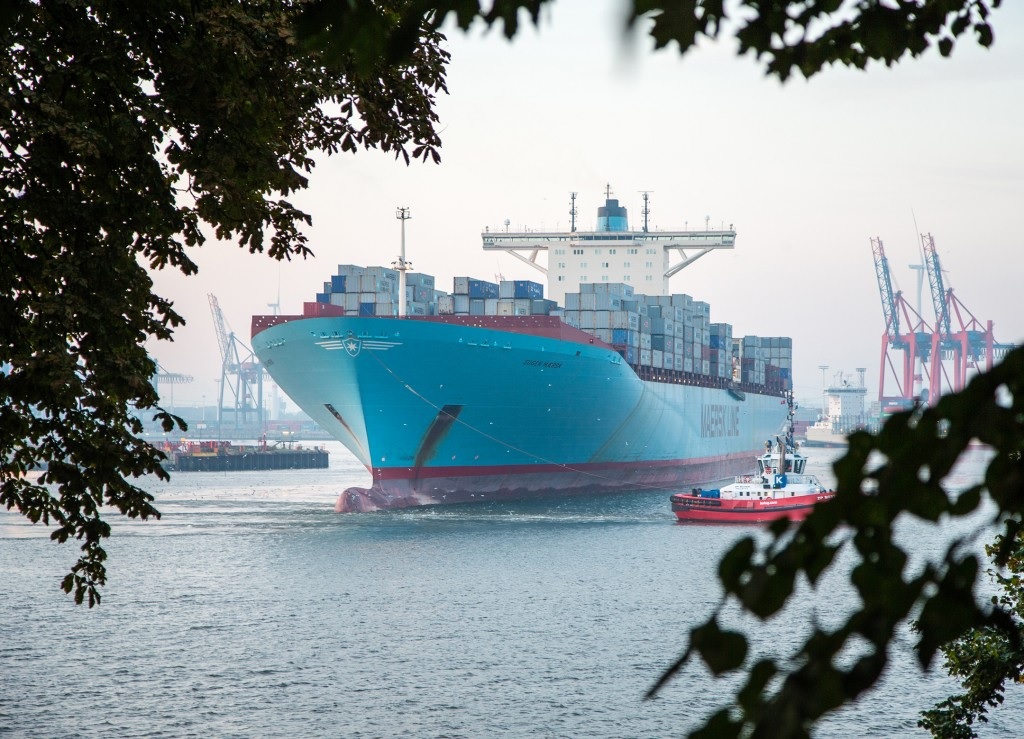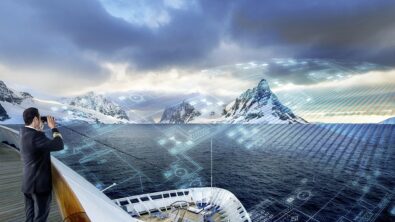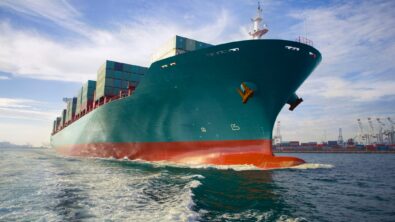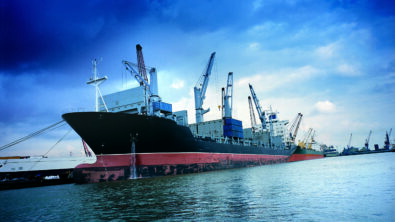Marine STS – New IMO standards are driving design change in the marine industry – Transcript

In the Marine Industry Podcast Series, Jan van Os is joined by Dejan Radosavljevic for a new series of episodes on STS in the marine industry, beginning with the ways new IMO standards are changing ship design, and how simulation can help with those changes.
Listen to the full episode or continue reading below for the transcript.
Blake Snodgrass: Hello and welcome to another Marine Industry Podcast Series. I’m your moderator, Blake Snodgrass, a writer for the Thought Leadership team at Siemens. I’m joined by our special guests and industry experts, Jan van Os, [Vice] President of the Marine Industry at Siemens Digital Industries Software, and Dejan Radosavljevic, Director of the Marine Industry at the simulation and test segment of Siemens Digital Industries Software. So welcome Jan and Dejan. Great to have you here today. And for a detailed synopsis of Jan and Dejan’s bios and backgrounds, please refer to our podcast’s blog page.
Blake Snodgrass: So let’s kick this podcast off with a general question about the current state of the marine industry. For the most part, we’ve been building ships probably the same as we’ve done in recent decades. So what are some of the key issues or challenges that the marine industry is facing and design and operation as they’re aiming to meet IMO directives, and how are those regulations shaking up the industry? Let’s start with you, Dejan.
Dejan Radosavljevic: So if I start, I think the goal posts have changed just a couple of weeks ago, earlier this month during the latest IMO MPC Committee meeting when they completely changed the targets for reaching net zero emissions from 2050 to from 50 percent to 100. Now that will have massive implication to how we design ships and the whole approach. The current design process doesn’t really allow for innovative approach. It relies a lot on traditional existing designs which have been in place for tens, and sometimes even 100 years, and relies on a very cumbersome long work process workflow where a lot of teams have to work in separate environments using separate tools trying to come together with a with a good design.
Dejan Radosavljevic: And that really is not sufficiently flexible to allow what is needed today and that is to be able to come up with completely new and innovative designs. And I think this is the real time where simulation can come into the fore and actually help ship designers come up with a much better way of designing and finding better solutions.
Jan van Os: Yeah. I fully agree on that, and if you look at the marine industry, then, let’s say, you look at the key drivers then sustainability is the most important key driver at the moment for our industry and that’s also a set by the IMO. And although they are having more stringent requirements now than last year or a couple of years ago, even bigger companies are setting their targets even a sharper than the 2050 net zero. If you look at Maersk, which is what the one of the biggest container lines, they are already said, “Okay, we want to be net zero by 2040.”
Jan van Os: So there is a huge goal on designing new kinds of vessels which can comply with those requirements. And it’s only the sustainability, but also due to sustainability and some of the other key drivers regarding interconnectivity and cost sensitive that the ships are getting more complex. So more systems, more equipment, more cables, more sensors, more of everything. So that means that the ships which are being built nowadays are more complex than a couple of years or a decade ago.
Jan van Os: So if you look at ship design and you look at the design spiral where you go through all the steps one by one and then iterating again and again, we have to start using simulation to do what a couple of those steps in one step, to let’s say, improve the design process, to increase the accuracy, but also to let’s say, mitigate some of the risks which are there in the design process. And simulation can help a lot, and also model based system engineering if, let’s say, you get rid of the design spiral and more go to the theme well then we can design ships more with simulation where you have a better understanding about how different systems are working or subsystems of systems are working. So that is a move which is happening at the moment, and is shipbuilding already embracing model-based system engineering? No, but it’s the way to deal with more complex ships and more challenging requirements.
Blake Snodgrass: Right. Thank you. So before we begin on discussing future ship design, let’s briefly touch on the current ship design process in terms of structures, weight, materials, that’s probably existed since the mid-20th century. Let’s just talk about that. The current design process.
Jan van Os: What I already said, the current design process is based on the design spiral and that is already there for many decades and that is going to change slowly in in a more system approach where you look at the requirements, look at analysis and design, go to the initial design and then go from vessel to system, to subsystem, to component and then build up again and do also the verification. So that’s a new way of let’s say setting up your ship model, your product breakdown structure, your work breakdown structure, to make sure that you can handle the complexity.
Jan van Os: And shipbuilding is not only producing drawings. It’s all about managing data. There are so much data involved in ship building nowadays because not only IMO requirements, but also other requirements are getting more stringen,t and you have to deal with all those requirements. And let’s say if you build a ship, you’ve got the shipyard, you’ve got the key suppliers, you’ve got the ship owner, you’ve got the classification societies, and then you’ve got all the regulatory bodies. So there’s a lot of data to manage so you cannot do that only with a CAD system anymore. No, you have to have a data management system on top to, let’s say, control and manage the data so it’s getting more data driven process than only a CAD driven process.
Dejan Radosavljevic: Yes. And the whole process is highly inefficient because you have disparate tools using by disconnected groups of people. And as Jan mentioned that there is much more data today, the ships are much more complex and it’s incredibly important for those teams and tools to seamlessly talk together and exchange that information. So integration of the process is really fundamental if we want to achieve efficient and aspect design and that’s where the digitalization and simulation really are the only way forward because they allow easy integration. Modern tools allow automation. So a lot of processes can be automated to move away the effort of engineers to spend time.
Dejan Radosavljevic: They can focus on the innovative side and let computers automatically run all kinds of simulations trying to find a set of objectives which best matches the specifications for the ship. So if we recall that, really, today ultimate objective is to design ships that are as energy efficient as possible, there is no way we can achieve that with the old processes in place. They have to be replaced by a digital platform which is fully integrated, automated, and relying on a single source of truth so that the data exchange can always be the current set of data.
Jan van Os: If you just look at the number, so don’t look at how ships are being designed and how it can be done better, but if you look at a number of ships and you look about the rules which are changing, there are approximately 100,000 plus ships, merchant ships, a sailing on the seas, and those are not the very small ones. They are above a certain GT number, but 100,000 ships, and that fleet is growing by 1.2, 1.5 percent a year. That is the prediction of [unintelligible]. And then some vessels are being scrapped, and then you have to renew vessels as well. So that means that on top of the new vessels and the vessels which are being scrapped, and you have to replace vessels because they have to comply with the rules.
Jan van Os: There needs to be quite some capacity to build those vessels and that means that also the time to market, so the design time, but also the building time, should be less than what we are doing now. An average ship can be up from 12 months up till three to four years, or naval vessels even much longer. But that means you have to compress the whole design and build process, and that’s why you need also to have better systems to control that process and to make sure that you have the right data at the right place at the right time. And that’s why shipbuilding is at the era of a change in how shipbuilding is being approached.
Blake Snodgrass: Great. I think you’ve already covered many areas and concepts of future of ship design, but let’s dive a little bit deeper into that and how future ships will be designed more holistically in terms of their parts, and then resolving incompatibilities, algorithms to meet requirements. If you could touch on a few of those items.
Dejan Radosavljevic: Well, if I start. It all comes down to how efficient the whole process needs to be in order to look at the holistic outcome. If we continue to look at different parts of the ship in isolation and try to find the solution, we will never achieve really what is needed today in terms of efficiency. So the approach has to be holistic, which means looking at the ship as a system, include all subsystems and components in one go. So being able to predict performance at any time, at any point during the design stage of the ship as a whole system. That is the only way to achieve the required level of efficiency for the future operation.
Dejan Radosavljevic: Luckily, we do have already technology in place that can allow that. From what we said earlier, single source of truth, which is kind of a database, the backbone which contains all the information about the ship at any point through its design process, and then the required tools that are fully integrated to allow for the system-level simulation, subsystem-level simulation, and seamless integration, interoperability between those components on the ship, so that ultimately we achieve the final goal of having the most efficient ship design in place.
Jan van Os: Yeah. And to add to that, let’s say a shipbuilder is in the assembly business. The shipbuilder is making the hull, designing the hull, but they are relying also on a lot of key suppliers, marine suppliers, but also the general suppliers, so it’s also very important in the whole ship design process to integrate the information from those suppliers into your design. Without it, you cannot design an efficient vessel. So that means also that you have to manage all those suppliers as a shipyard, snd that means that you have to need the data where they can pull data out of a system instead of pushing it to the various suppliers. And that’s also important to get more efficient approaches of design and build.
Blake Snodgrass: Thank you for that answer, Jan. And we look to be out of time for now for this first podcast, but I want to thank again Jan and Dejan for their contribution today. And we look forward to subsequent podcasts in this marine podcast series. So thank you to our listeners. Goodbye!
Siemens Digital Industries Software helps organizations of all sizes digitally transform using software, hardware and services from the Siemens Xcelerator business platform. Siemens’ software and the comprehensive digital twin enable companies to optimize their design, engineering and manufacturing processes to turn today’s ideas into the sustainable products of the future. From chips to entire systems, from product to process, across all industries. Siemens Digital Industries Software – Accelerating transformation.


